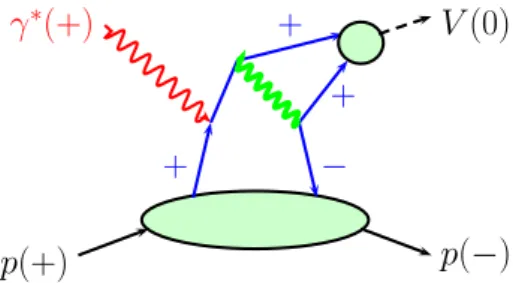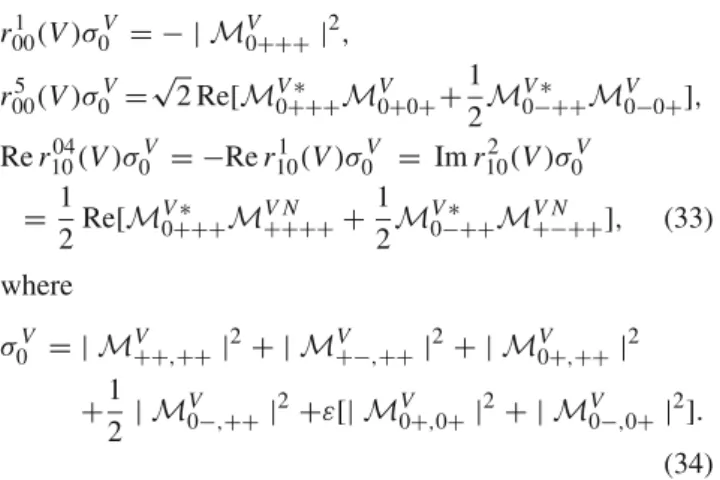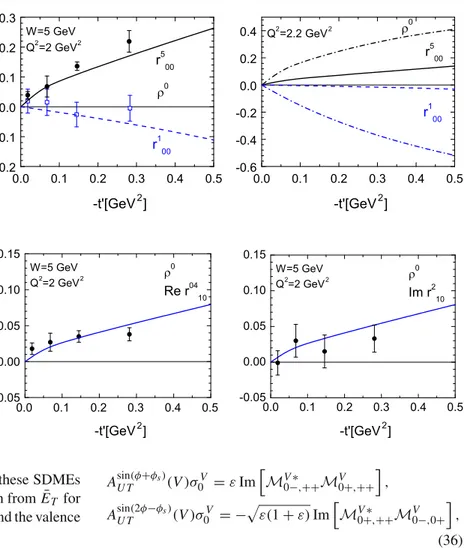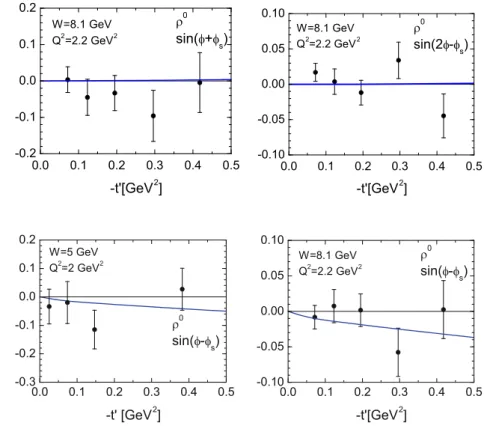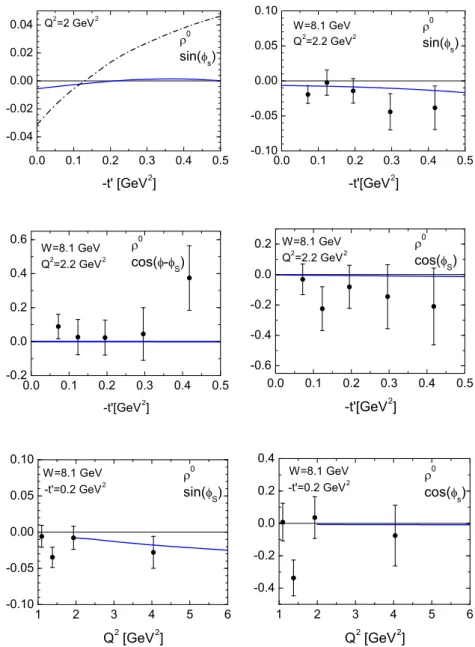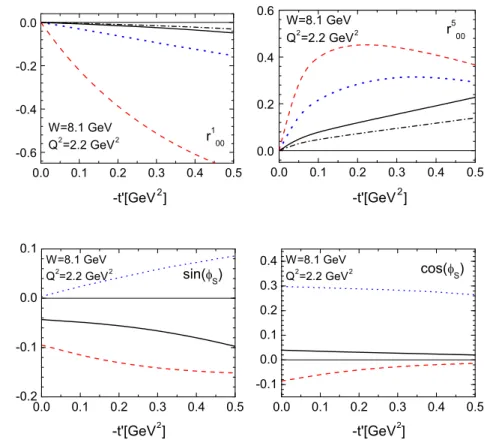Regular Article - Theoretical Physics
Transversity in exclusive vector-meson leptoproduction
S. V. Goloskokov1,a, P. Kroll2,3,b
1Bogoliubov Laboratory of Theoretical Physics, Joint Institute for Nuclear Research, Dubna 141980, Moscow region, Russia
2Fachbereich Physik, Universität Wuppertal, 42097 Wuppertal, Germany
3Institut für Theoretische Physik, Universität Regensburg, 93040 Regensburg, Germany
Received: 15 October 2013 / Accepted: 23 December 2013 / Published online: 5 February 2014
© The Author(s) 2014. This article is published with open access at Springerlink.com
Abstract The role of transversity or helicity-flip general- ized parton distributions (GPDs) in leptoproduction of vector mesons is investigated within the framework of the handbag approach. The transversity GPDs in combination with twist-3 meson wave functions occur in the amplitudes for transitions from a transversely polarized virtual photon to a longitudinal polarized vector meson. The importance of the transversity GPDs can be examined in some of the spin density matrix elements and in transverse target spin asymmetries. Using suitable parametrizations of both helicity-flip and -non-flip GPDs, which are essentially taken from our previous papers, we estimate these observables and compare the results with available data.
1 Introduction
While, in the framework of the handbag approach, the roles of the helicity-non-flip GPDs, H,E,H and E , in deeply virtual Compton scattering and in exclusive meson leptoproduction have intensively been studied during the last 15 years, the applications of the transversity or helicity-flip GPDs are rare.
Only a few publications on this issue can be found in the lit- erature, e.g. [1–10]. This is in sharp contrast to the situation of transversity in semi-inclusive reactions where a rich liter- ature exists, see for instance the review articles [11,12]. The reason for this fact is that, for the quark transversity GPDs, the emitted and reabsorbed partons have opposite helicities.
Since the interactions of light quarks with gluons or photons conserve helicity, the initial parton helicity flip can only be compensated by higher-twist meson wave functions. There- fore, the contribution from the quark transversity GPDs are small in most cases and are difficult to separate from those of the helicity non-flip GPDs. For the gluon transversity GPDs
ae-mail: goloskkv@theor.jinr.ru
be-mail: kroll@physik.uni-wuppertal.de
the situation is different but it seems that their contributions are even smaller.
Leptoproduction of pseudoscalar mesons is an exception.
On the one hand, the contributions fromH and E are rather small in this case. On the other hand, those from the transver- sity GPDs are comparably large since their contributions are enhanced by the chiral condensate which appears in the wave function for a (ground state) pseudoscalar meson [9]. This fact entails the dominance of the amplitudes for the tran- sitions from a transversely polarized virtual photon to the pseudoscalar meson,γT∗ → P. The asymptotically leading amplitudes for the transitions from a longitudinally polar- ized photon, γL∗ → P, are much smaller according to the estimates made in [9,10]. The only substantial contributions to these amplitudes are the meson-pole terms as, for instance, the pion pole inπ+leptoproduction.1
Here, in this work, we are going to investigate the role of the transversity GPDs in vector-meson leptoproduction.
We will utilize the parametrizations of the helicity-non-flip GPDs advocated for in [13] as well as those of the valence- quark transversity GPDs used in our study of leptoproduction of pseudoscalar mesons [9,10]. In addition we will allow for sea-quark contributions from these GPDs, which, as it turns out, play only a minor role. With regard to the prominent role of the transversity GPDs in pion leptoproduction [9,10]
it seems legitimate to examine the size of their contributions to vector-meson leptoproduction without carrying out a sys- tematic analysis of all possible corrections to a given order of accuracy. As in [9,10] we will not perform detailed fits to experimental data. In so far the results we will present below are to be understood as estimates. A more exact determination of the transversity GPDs is to be left for future investigations.
1 The pion-pole contribution dominates theπ+cross section at small momentum transfer, as is well known. However, this result cannot be considered as a success of the handbag approach. A calculation of the π+cross section from LO Feynman graphs (see Fig.1) underestimates it markedly.
Prerequisite to such an analysis are data on, say, theπ0cross section at reasonably large photon virtuality, Q2, and large c.m.s. energy, W . Such data may come from the COMPASS experiment or the upgraded Jefferson Lab.
The plan of the paper is the following: In the next sec- tion we will outline the handbag approach, referring to our previous work [9,10,13,14] and giving only details for the treatment of the contributions from the transversity GPDs.
In this section we will also discuss the calculation of the subprocess amplitude for quark helicity flip and present the parametrizations of the GPDs. In Sect.3we will present our results for those observables of vector-meson leptoproduc- tion which are sensitive to the transversity GPDs. The paper is closed with a summary.
2 The handbag approach
We consider the process γ∗(q, μ)p(p, ν) → V(q, μ) p(p, ν)in the generalized Bjorken-regime of large Q2and large W but fixed Bjorken-x, xBj. The symbols in the brackets denote the momenta and the helicities of the particles. The square of the momentum transfer,= p−p, is assumed to be much smaller than Q2(t =2). We also restrict ourselves to small values of xBj, i.e. to values of the skewness, ξ = (p−p)+
(p+p)+ xBj
2−xBj(1+m2V/Q2), (1) smaller than about 0.1 (mV denotes the mass of the vector meson V ). We stress that throughout the paper we neglect terms which are suppressed as√
−t/Q or stronger. We will work in a photon–proton center-of-mass system where the proton momenta are defined as p= ¯p−/2 and p= ¯p+ /2. The average proton momentum is p¯ =(p+p)/2 and we choose its three-momentum part to point along the 3-axis.
As described in detail in [13,14] a helicity amplitude Mμν,μνis assumed to factorize in a hard subprocess ampli- tude Hμλ,μλ (where λ is the helicity of the internal par- tons, quarks or gluons) and a soft proton matrix element, parametrized in terms of GPDs, see Fig.1. Since the partons which are emitted and reabsorbed from the proton collinearly to its initial and final state momentum, have the same helicity in this subprocess amplitude the GPDs H and E appear in the convolution. There are, however, also small, nearly negligi- ble contributions fromH and E to the μ= ±1 amplitudes.
The subprocess amplitudes are calculated within the mod- ified perturbative approach [15] in which quark transverse degrees of freedom in the subprocess as well as Sudakov suppressions are taken into account. This entails the neces- sity to use a light-cone wave function for the meson instead of a distribution amplitude. In the limit of Q2,W → ∞ the subprocess amplitudes for transitions from a longitudi- nally polarized photon to a likewise polarized vector meson,
Fig. 1 A typical graph for meson leptoproduction. The helicity labels refer to the amplitudeM0−,++and to the subprocessγ∗q→(qq¯)q γL∗ → VL, can be shown to turn into the collinear result, i.e. the familiar asymptotic factorization formula emerges for the amplitudeM0ν,0ν. The factorization ofM0ν,0νhas rigorously been proven to hold in the limit of Q2,W → ∞ [16,17]. The infrared singularities known to occur in the sub- process amplitudes for transversely polarized photons and mesons H±λ,±λV in collinear approximation, are regularized by the quark transverse momentum, k⊥, in the modified per- turbative approach. (Note that explicit helicities are labeled by their signs or by zero.) The γT∗ → VT amplitudes are therefore suppressed by
k⊥2/Q with respect to those for
γL∗ → VL transitions.2 For further details of the handbag approach we refer to [13,14].
The role of the transversity GPDs [1,19] HT, E¯T = 2HT+ET,. . .in exclusive leptoproduction of pseudoscalar mesons has been investigated in [9,10]. Since for these GPDs the emitted and reabsorbed partons have opposite helicities they only contribute to the amplitudes for transversely polar- ized photons to the order of accuracy we are working. As dis- cussed in [9,10] the contributions from the transversity GPDs seem to be dominant in most of the pseudoscalar channels.
For instance, the transverse cross section forπ0production is estimated in [10] to be about 10 times larger than the lon- gitudinal cross section which seems to be in agreement with experiment [20,21].
Here, in this work we are going to explore the role of the transversity GPDs in vector-meson leptoproduction. In full analogy to the case of pseudoscalar mesons the quark transversity GPDs contribute to the amplitudesMV0ν,±ν for γT∗→VL transitions:
MV0+,++= e0 2
√−t 2m
a
eaCVa
dx
λ
2λH0λ,+−λV
× (E¯Ta −ξETa)+H0λ,+−λV (ETa −ξEaT) , MV0+,−+= −e0
2
√−t 2m
a
eaCVa
dx
λ
2λH0λ,+−λV
× (E¯Ta −ξETa)−H0Vλ,+−λ(ETa −ξEaT) ,
2 For a different treatment ofγT∗→VT transitions see [18].
M0−,++=e0
1−ξ2
a
eaCVa
×
dx H0V−++
HT+ ξ
1−ξ2(EaT −ξEaT)
+ t 2m2
λ
λH0Vλ,+−λHTa
, MV0−,−+=e0
1−ξ2
a
eaCVa
×
dx H0−−+V
HTa+ ξ
1−ξ2(EaT−ξEaT)
− t 2m2
λ
λH0λ,+−λV
HTa
. (2)
As independent amplitudes we choose those withν =1/2.
The amplitudes withν= −1/2 are related to the other ones by parity conservation:3
M−μV −ν,−μ−ν = (−1)μ−ν−μ+νMVμν,μν. (3) Since we neglect contributions which are suppressed at least by√
−t/Q, only helicity-non-flip subprocess amplitudes can appear in the convolutions (2). For quark helicity-flip the only subprocess amplitude of this type is H0V−,++(=H0V+,−−) and, hence, only the γT∗ → VL transitions are fed by the transversity GPDs to the order of accuracy we are working.
The expressions (2) can easily be derived with the help of the proton–quark matrix elements given in [19]. In (2) m is the proton mass, a denotes the quark flavor and eathe quark charges in units of the positron charge, e0. For unflavored mesons the non-zero flavor weight factors,CaV, read Cρu0 = −Cρd0 = Cuω = Cωd = 1/√
2, Cφs = 1. (4) For the flavored mesons,ρ+and K∗0, the p→n and p→ + transition GPDs appear. As a consequence of isospin symmetry or SU(3) flavor symmetry the transition GPDs can be related to the corresponding proton GPDs [22]4
Kρ+ = Ku−Kd, KK∗0 = −Kd+Ks, (5) where K is some GPD. For these mesons there are no flavor weight factors and the charges have to be absorbed into the subprocess amplitudes. Finally, t=t−t0where
t0 = −4m2 ξ2
1−ξ2 (6)
is the minimal value of−t allowed in the process in question.
Since we only consider small values of the skewness−t0is very small and the difference between tand t is tiny.
3 This relation holds analogously for the subprocess amplitudes.
4 The different masses of the nucleon and the hyperon are taken into account as in [34].
An interesting property of the helicity amplitudes can be inferred from (2). With the help of parity conservation one sees that part of the amplitudes (2) behave like those for the exchange of a particle with either natural (N ) or unnatural parity (U )
MV N−μν,−μν =(−1)μ−μMμV Nν,μν,
MV U−μν,−μν = −(−1)μ−μMV Uμν,μν. (7) Thus, the combinationsE¯T −ξE and HT behave like natu- ral parity exchange whileET −ξET behaves like unnatural parity. Remarkably, the proton helicity-flip amplitudes in (2) cannot be splitted in natural and unnatural parity contribu- tions completely. Such a behavior of the amplitudeM0−,++
is known to hold for photoproduction of pions since the late- 1960s [23] and was the reason for the introduction of Regge cuts. According to [9] the GPDs H (H ) and E ( E) also behave like (un)natural parity exchange. TheγT∗→ VT amplitudes can therefore be written as
M+±,++V = MV N+±,+++M+±,++V U . (8) OtherγT∗ → VT amplitudes are related to these amplitudes either by the symmetry (7) or by parity invariance. The ampli- tude MV U+−,++ is fed by the ξE [14]. Since we are inter-˜ ested in small skewness and since it is no reason known why E could be larger than the other GPDs we neglect it. Also˜ the contribution from the pion pole (contained in E ) to the˜ observables of interest in this paper is negligible small, even for the case of ωproduction where it is three times larger than forρ0production.
With regard to the fact that the GPD ET is antisymmet- ric inξ:ET(ξ)= −ET(−ξ), we neglect ET and ET in (2) for small skewness. Moreover, we also neglect the amplitude H0V−,−+in (2) since it proportional to t/Q2due to angular momentum conservation in contrast to the helicity-non-flip amplitude H0V−,++, which is not forced to vanish for forward scattering by this conservation law. Finally, we disregard the GPDHTin (2) by the admittedly weak argument that its con- tribution is proportional to t/(4m2). Taking all these simpli- fications into account the amplitudes given in (2) reduce to M0V−,++=e0
a
eaCaV
×
dx H0V−,++(x, ξ,Q2,t=0)HTa(x, ξ,t), M0V+,±+= ∓e0
√−t 4m
a
eaCaV
×
dx H0V−,++(x, ξ,Q2,t=0)E¯Ta(x, ξ,t), M0V−,−+=0. (9) Although the transversity GPDs are leading twist, the ampli- tudes given in (2) and (9) are of twist-3 nature. Quark and
antiquark forming the valence Fock state of the longitudinally polarized vector meson have the same helicity in H0V−,++, see Fig.1. This necessitates the use of twist-3 meson wave functions which will be discussed in Sect.2.1.
We repeat that (9) only refers to the quark transversity GPDs. The contributions from their gluonic partners require the non-flip subprocess amplitude H−−,++V , i.e. the ampli- tude with gluon as well as photon–meson helicity flip (all helicities are either plus or minus 1). The convolutions of H−−,++V and the gluonic transversity GPDs determine the γT∗ → V−T amplitudesMV∓ν,±ν. As is well-known from the SDMEs forρ0andφproduction (e.g. r111) measured for instance by HERMES [24] and H1 [25], these amplitudes are very small, compatible with zero within errors and usually neglected in analyses of vector-meson leptoproduction.5We will do so here as well. SmallγT∗ → V−T amplitudes are consistent with the assumption of small gluonic transversity GPDs. This assumption is not in conflict with rather large quark transversity GPDs since the quark and gluon transver- sity GPDs evolve independently with the scale [1,26]. The amplitudes forγL∗ → VT transitions will be neglected too.
They are experimentally small [24,25] and strongly sup- pressed in the handbag approach.
2.1 Calculation of the twist-3 subprocess amplitude We begin with the discussion of the light-cone wave func- tion for the valence Fock component of a helicity-zero vector meson that moves along the 3-direction and for which quark and antiquark have the same helicity, see Fig.1. Obviously, this configuration requires one unit of orbital angular momen- tum projection l3. Such a light-cone wave function has been given in [27] recently
|V;q, μ=0,|l3| =1
= 1
√2
dτd2k⊥
16π3 V(2)(τ,k⊥2) 1 mV
√ττ¯
×
k⊥−b†+(τ,k⊥)d+†(¯τ,−k⊥)
− k⊥+b†−(τ,k⊥)d−†(τ,¯ −k⊥)
|0, (10) Color and flavor factors are omitted for convenience. The quark fields, b†and d†, depend on the momentum fractions τ andτ¯ ≡1−τ of the meson’s momentum, q, and on the quark transverse momentum, k⊥. The combinations of its one- and two-components
k⊥± = k1⊥±i k⊥2 (11)
5As shown in [1,2] the gluon transversity GPDs contribute to theγT∗→ γ−TDVCS amplitudes to NLO.
represent one unit of l3. Acting on the perturbative vacuum the quark fields create quark and antiquark momentum eigen- states
|q(τ,k⊥);λ =b†qλ(τ,k⊥)|0,
| ¯q(τ,¯ −k⊥);λ =dq†λ(¯τ,−k⊥)|0. (12) It has been shown in [27] that the wave function (10) has the correct behavior under the parity operation for a helicity- zeroρ meson. In contrast to [27] we divide by the meson mass in order to have a scalar wave function (2) of the same dimension as the wave function(1)appearing in the expression for the usual l3=0 Fock component of the vector meson
|V;q, μ=0,lz =0 = 1
√2
dτd2k⊥
16π3 V(1)(τ,k⊥2) 1
√ττ¯
×
b†+(τ,k⊥)d−†(τ,¯ −k⊥)+b−†(τ,k⊥)d+†(τ,¯ −k⊥)
|0. (13) The states (10) and (13) respect covariant particle state nor- malization. Hence, the probabilities of the| l3 | = 1 and 0 Fock components are given by
dτd2k⊥ 16π3
k2⊥
m2V |V(2)(τ,k⊥2)|2=P|l3|=1, dτd2k⊥
16π3 |V(1)(τ,k2⊥)|2= Pl3=0,
(14)
with P|l3| =1+Pl3=0≤1. The spin part of (10) is equivalent to the following expression:
|l3|=1= 1
√2mV
q/k/+mVk/− k⊥2
2ττ¯+k⊥2 τ¯−τ 2ττ¯mV
q/+O(k3⊥)
. (15) for an incoming vector meson. The four-vector k is defined as
k = [0,0,k⊥], (16)
in light-cone coordinates. This spin wave function can be transformed to the frame we are working by a transverse boost. The equivalence of (15) and the spin part of (10) can readily be derived. Representing the parton states in (10) by Dirac spinors in the rest frame, one sees
k⊥−u+(0)v¯+(0)−k+⊥u−(0)¯v−(0) = 1
2(1+γ0)k/. (17) A boost of this expression to the frame where the meson moves rapidly along the 3-axis leads to
k⊥−u+(τ,k⊥)¯v+(τ,¯ −k⊥)−k+⊥u−(τ,k⊥)v¯−(¯τ,−k⊥)
∼(p/1+m1)(q/+mV)k/(−p/2+m2) (18)
with the quark and antiquark momenta being defined as p1= τq+,τ2m2V+k⊥2
2τq+ ,k⊥
, p2= τ¯q+,τ¯2m2V+k⊥2
2τ¯q+ ,−k⊥
. (19)
The quark and antiquark masses are taken as m1 = τmV
and m2 = ¯τmV. This guarantees that q = p1+ p2up to corrections of order k⊥2. From (18) one easily derives (15).
By counting the numbers ofγ matrices in the Feynman expression for this amplitude (including the two from the proton matrix element for parton helicity flip) one sees that only the first and the third term of the spin wave function (15) contribute to the parton helicity-flip amplitude. The first term, q/k/, leads to a contribution of order t/Q2and is conse- quently neglected. Hence, the subprocess amplitude H0V−,++
is generated by the third term. Performing the LO calculation of H0V−,++from that term and the set of Feynman graphs of which an example is shown in Fig.1, we obtain
H0−,++V =32πmVξ Q2
CF
√Nc
dτ dk⊥2
16π2 k2⊥
2ττ¯m2VV(2)(τ,k⊥2)
×αs(μr)
1 x−ξ+i
1
¯
τ(x−ξ)−2ξk2⊥/Q2+i + 1
x+ξ−i
1
τ(x+ξ)+2ξk⊥2/Q2−i
. (20) The number of colors is denoted by Nc, CF =4/3 andμR
is an appropriate renormalization scale (see below). Equa- tion (20) holds for unflavored vector mesons. As we already mentioned for flavored mesons built up by a quark qaand an antiquarkq¯b, the corresponding quark charges eaand ebmul- tiply the first and second term of (20), respectively. Follow- ing [15] we only retain k⊥2 in the denominators of the parton propagators. There the parton transverse momentum plays a decisive role since it competes with the terms∝τ(τ)¯ Q2, which become small in the end-point regions where eitherτ orτ¯tends to zero. We stress that, to the order of accuracy we are working, the amplitude (20) respects gauge invariance.
The distribution amplitude associated with the third term of the wave function (15), reads
dk2⊥ 16π2
k⊥2
2ττ¯m2V(V2)(τ,k2⊥) = fVT 2√
2Nc
h(sV)(τ). (21) According to [28], the twist-3 chiral-odd distribution ampli- tude h(s)is defined by the meson-vacuum matrix element6
0| ¯q(z)q(−z)|V;q, μ=0 (22)
6 A second twist-3 helicity-flip distribution amplitude, h(Vt), [28] is associated with the q/k/-term of the|l3| =1 wave function.
(a path-ordered gauge factor along the straight line connect- ing the points z and −z is understood). This distribution amplitude comes along with the tensor decay constant fVT of the vector meson. The latter depends on the factorization scaleμFto be specified below
fVT(μF) = fVT(μ0)
αs(μF) αs(μ0)
4/27
. (23)
For the tensor decay constant we use the QCD sum rule esti- mate give in [29]. According to this work it amounts to about 0.8 times the usual decay constant of a longitudinally polar- ized l3=0 vector meson at the scaleμ0=1 GeV. As a con- sequence of the nature of the wave functionV(2)the subpro- cess amplitude H0V−,++is of twist-3 accuracy and is paramet- rically suppressed by mV/Q as compared to the leading-twist amplitudes H0V+,0+. Our results for theγT∗→VLamplitudes are therefore consistent with the statements made in [4,5]
that the transversity GPDs do not contribute to vector-meson leptoproduction at leading-twist accuracy.
In principle, there is also a contribution to H0−,++from the qq g Fock component of the vector meson. The corre-¯ sponding wave function and distribution amplitude is twist-4 and is interrelated to the wave function(V2)by the equation of motion [28]. The inclusion of the three-particle Fock com- ponent in the analysis will only change the strength of the γT∗ → VL amplitudes somewhat. Since the present knowl- edge of the qq g wave function is rather limited, we ignore this¯ contribution in consistency with our analysis of pion produc- tion [9,10]. The neglect of the three-particle wave function implies that the distribution amplitude h(s)takes the asymp- totic form 6ττ¯. The role of the three-particle contribution is explored in general higher-twist scenarios in [30].
In the modified perturbative approach we are using, the amplitude (20) is Fourier transformed from the k⊥-space to the canonically conjugated impact parameter space b, for details see [13]. The obtained b-space expression is multi- plied with the Sudakov factor, exp[−S(τ,b,Q2)], represent- ing gluon radiation calculated to next-to-leading-log accu- racy using resummation techniques and having recourse to the renormalization group [15]. The impact parameter b, which is the quark–antiquark separation, acts as an infrared cut-off. Radiative gluons with wave lengths between the infrared cut-off and a lower limit (related to the hard scale Q2) yield suppression; softer gluons are part of the meson wave function, while harder ones are an explicit part of the subprocess amplitude. Consequently, the factorization scale is given by the quark–antiquark separationμF = 1/b. The renormalization scale, μR, is taken to be the largest mass scale appearing in the subprocess amplitude, i.e. μR = max(τQ,τ¯Q,1/b). ForQCDa value of 220 MeV is used in the Sudakov factor and in the evaluation of αs from the one-loop expression.
2.2 Parametrization of the GPDs
In order to evaluate the convolutions in (9) and the analogous ones for the other amplitudes we need the GPDs. We adopt for them the parametrizations proposed in our previous work [9,10,13]. The GPDs are constructed from the zero-skewness GPDs with the help of the double distribution ansatz [31]
Ki(x, ξ,t)
= 1
−1
dρ
1−|ρ|
−1+|ρ|
dηδ(ρ+ξη−x)Ki(ρ, ξ=0,t)wi(ρ, η), (24) where K is a GPD and i stands for gluon, sea or valence quarks. A possible D term [32] is neglected. For the weight functionwthat generates the skewness dependence we use [33]
wi(ρ, η) = (2ni+2) 22ni+12(ni +1)
[(1− |ρ|)2−η2]ni (1− |ρ|)2ni+1 . (25) For the parameter ni a value of 2 is taken for the gluon and sea-quark helicity-non-flip GPDs and 1 in all other cases.
The zero-skewness GPDs are parametrized as
Ki(ρ, ξ =0,t) = ki(ρ)exp[t pki(ρ)], (26) where ki is the forward (t =0) limit of the zero-skewness GPD which for H ,H and H T are the unpolarized, polarized and transversity PDFs, respectively. For the other GPDs the forward limits are parametrized like the PDFs
ki(ρ) = Nkiρ−αki(1−ρ)βki. (27) The profile function pkiin (26) is parametrized in a Regge- like manner
pki(ρ) = −αkiln(ρ)+bki, (28) whereαki represents the slope of a Regge trajectory and bki
parametrizes the t dependence of its residue.
The best determined GPD is H , since it controls the cross sections for leptoproduction of flavor-neutral vector mesons.
The values of the parameters which specify H , are obtained from fits to the cross section data at small skewness and can be found in [13]. The GPDs H and E play no role in the observables we are going to discuss below. The GPD E for the valence quarks, on the other hand, is of impor- tance for some of the observables of interest. The values of its parameters are given in [13,34]. This parametrization of E for valence quarks at zero skewness is in agreement with the findings of an analysis of the nucleon form factors in terms of GPDs [35]. According to this analysis the second moments of E for u and d valence quarks at t = 0 have about the same magnitude but opposite sign. Due to a sum rule for the second moments of E atξ = t = 0 [36,37]
the respective moments for the gluon and sea quarks cancel each other to a large extent. Since, for our parametrization, the zero-skewness GPDs have no nodes except at the end points x =0 and 1, this cancellation approximately happens for other moments too. It even approximately occurs for the convolutions with the subprocess amplitudes. For this reason we do not consider E for gluons and sea quarks in this work.
In passing we note that the set of helicity-non-flip GPDs pro- posed in [13,34] has been examined in a calculation of DVCS to leading-twist accuracy and leading-order of perturbative QCD [38]. The results are found to be in satisfactory agree- ment with all small-skewness data. Recently the form-factor analysis from 2004 [35] has been updated [39]. All the new data on the nucleon form factors are taken into account in the update as well as more recent parton distributions [40].
The zero-skewness valence-quark GPDs H and E obtained in this analysis do not differ much from those proposed in the 2004 analysis at low−t . We checked that the use of these new valence-quark GPDs do not alter our results perceptibly.
The only available small-skewness data which provide clear evidence for strong contributions from transversely polarized virtual photons and therefore information on the transversity GPDs, are theπ+electroproduction cross sec- tion [41] and the asymmetries measured with a transversely polarized target [42]. However, the π+ data provide only information on the combination HTu−HTd. The forward limit of HT is the transversity distribution,δ(x), which has been determined by Anselmino et al. [43] in an analysis of the data on the azimuthal asymmetry in semi-inclusive deep inelastic lepton–nucleon scattering and in inclusive two-hadron pro- duction in electron–positron annihilation. The moments of the transversity distributions proposed in [43], i.e. the lowest moments of HT at t = 0, are about 40 % smaller than a lattice QCD result [44], they are also substantially smaller than model results (cf. [43] and references therein). Also the analysis of π0 leptoproduction performed in [10], suggest larger moments of HT. In order to surmount this difficulty we leave unchanged the parametrization of the transversity distributions given in [10,43] but adjust their normalizations to the lattice QCD moments of [44]. The other transversity GPD, E¯T, is only constrained by lattice QCD results [45], its contribution toπ+production is very small. The values of the parameters for the valence-quark GPDs HT and E¯T
proposed in [10], are quoted in Table1. Given the uncer- tainties of the present lattice QCD results [46] we consider these parametrizations as rough estimates which only allow exploratory studies of transversity effects in exclusive meson leptoproduction. In other words, we only achieve estimates of various observables. For this reason we do not attempt an error assessment of our results; this is beyond feasibility at present. Evolution of the transversity GPDs is not taken into account; all pertinent experimental data cover only a very limited range of Q2.
Table 1 Parameters for the transversity GPDs at a scale of 2 GeV GPD αki βki αki (GeV−2) bki (GeV−2) Nki
HTuv – 5 0.45 0.3 1.1
HTdv – 5 0.45 0.3 −0.3
HTs 0.6 7 0.45 0.5 −0.17
¯
EuTv 0.3 4 0.45 0.5 6.83
¯
EdTv 0.3 5 0.45 0.5 5.05
¯
EsT 0.6 7 0.45 0.5 −0.10
The last item we have to specify are the sea-quark transver- sity GPDs. A flavor symmetric sea is assumed with the parameters quoted in Table1. These parameters are adjusted to the data discussed below.
The l3 = 0 wave functions for the vector mesons are specified in [13,34]. Basically they are simple Gaussians in k⊥. This type of wave function is also used for the scalar
|l3| =1 wave function V(2)(τ,k⊥2)=16π2
2NcfVTm2VaV T4 exp[−a2V Tk2⊥/(ττ)].¯ (29) Its associated distribution amplitude is just the asymptotic form for mesons
h(sV) =6ττ.¯ (30)
In principle, this is the leading term of a Gegenbauer series [28]. We, however, disregard all higher Gegenbauer terms except of the C13/2-term for the K∗0 meson for which we take a value of 0.1 for its coefficient. As discussed in [47]
the higher Gegenbauer terms are strongly suppressed in the modified perturbative approach.
The wave function (29) leads to the probability of the
|l3|=1 Fock component P|l3|=1 = 4
15πNc(fVTmVaV T2 )2 (31) and the r.m.s. k⊥is
k⊥2 = 3
14a−V T2. (32)
With aρT 1 GeV and fρT =167 MeV (see [13]) one finds the plausible values P|l3|=1=0.13 and k2⊥1/2=0.46 GeV.
3 Results
3.1 Spin-density matrix elements
TheγT∗ → VL amplitudes can be probed by some of the SDMEs. Using the simplifications discussed in Sect.2, one finds for the relevant SDMEs [48]
r001(V)σ0V = − |MV0+++|2, r005(V)σ0V=√
2 Re[M0V+++∗ M0V+0++1
2MV0−++∗ MV0−0+], Re r1004(V)σ0V = −Re r101(V)σ0V = Im r102(V)σ0V
= 1
2Re[MV0+++∗ MV N+++++1
2MV0−++∗ MV N+−++], (33) where
σ0V = |MV++,++|2+ |MV+−,++|2+ |M0V+,++|2 +1
2 |MV0−,++|2+ε[|MV0+,0+|2+ |MV0−,0+|2].
(34) The ratio of the longitudinal and transverse photon flux is denoted byε. Up to a phase space factor,σ0V is the unsepa- rated cross section dσ =dσT+εdσL. The contribution from theγT∗ →VL amplitudes to the transverse cross section for ρ0production is negligibly small, it amounts to only 2–3 %.
A particularly interesting SDME is r001. It measures the absolute value of the amplitudeM0+++, which is fed by the GPDE¯Tin the combination euE¯Tu−edE¯Tdforρ0production, see (4) and (9). Since E¯Tu and E¯Td have the same sign and almost the same strength, this amplitude is rather large. The signs of these GPDs are fixed by the lattice QCD results [45]. In fact, for the tensor anomalous magnetic moment of the nucleon which represents the lowest moment of E¯T at t =0,κTu κTd >0 is found in [45]. Models support this result [49,50].
The SDME r005 is more complicated. It measures the real part of a combination of two interference terms; in terms of GPDs
r005 ∼Re
¯ET∗L T HL L+1
2 HT∗L T EL L
(35) where KX Y denotes the convolution of the GPD K with the subprocess amplitude for aγY∗→ VX transition (X,Y label longitudinal or transverse polarization). I.e. r005 is related to interference terms of amplitudes fed by transversity GPDs with leadingγL∗ → VL amplitudes. The first term in (35) dominates by far since HL L is much larger than EL L
while both transversity contributions are of roughly the same strength. Thus, r005 essentially probesE¯T, too. As is to be seen from Fig.2we achieve fair agreement between the HERMES data onρ0production [24] and our handbag results for r001 and r005. A point worth mentioning is that r005 ∝ √
−t and r001 ∝tfor t→0 as a consequence of angular momentum conservation.
Also for the SDMEs Re r001, Re r1004 and Im r102 we find good agreement with the data onρ0production, see Fig.3 for the latter two SDMEs. Within the handbag approach the three SDMEs are equal (up to a sign) and probe a similar com- bination of interference terms as r005. The difference is that for these SDMEs H and E are convoluted with the subpro-
Fig. 2 Left Handbag results for the SDMEs r005 (solid line) and r001 (dashed line) forρ0 production. Data taken from HERMES [24]. Right Predictions for r005 and r001 at W=8.1 GeV (solid and dashed line, respectively) and W=3 GeV (dash-dotted lines)
Fig. 3 The SDMEs Re r1004and Im r102. Data taken from HERMES [24]. The solid lines represent our results
cess amplitude forγT∗ → VT transitions. For these SDMEs theE¯T term is also dominant. The contribution fromE¯T for the sea quarks is less than 5 % for all SDMEs, and the valence quarks dominate.
These results are an addendum to our previous study of SDMEs [13]. In summary we achieve a fair description of all SDMEs within the handbag approach now. An exception is the relative phase between the amplitudes forγT∗ → ρT0 andγL∗→ρ0L transitions which is too small in the handbag approach as compared to experiment [24]. It would be of interest to probe the transversity contributions to the SDMEs also at other energies. As an example we show in Fig.2r005 and r001 at the COMPASS energy of 8.1 GeV and at 3 GeV, which is typical of the upgraded JLab.
3.2 Transversely polarized target asymmetries
There are the following non-zero modulations of the trans- verse target spin asymmetry AU T:
AsinU T(φ−φs)(V)σ0V
= −2 Im
εMV0−,∗0+MV0+,0++M+−,++V N∗ M++,++V N +1
2MV0−,++∗ M0V+,++
,
AsinU T(φs)(V)σ0V
=
ε(1+ε)Im
MV0+++∗ MV0−0+−MV0−++∗ MV0+0+ ,
AsinU T(φ+φs)(V)σ0V =εIm
MV0−,++∗ MV0+,++
, AsinU T(2φ−φs)(V)σ0V = −
ε(1+ε)Im
MV0+,++∗ M0V−,0+
, (36) which can easily be derived from the expressions given in [51].7 Here, φ is the azimuthal angle between the lepton and the hadron plane andφs specifies the orientation of the target spin vector with respect to the lepton plane. It is to be stressed that the COMPASS collaboration [52], which has measured these modulations recently, took out the ε- dependent prefactors√
ε(1±ε)andε(for the sin(φ+φs) modulation) in their definition of the asymmetries (ε0.8 for HERMES and0.96 for COMPASS kinematics).
The sin(φ−φs)modulation of AU T has been measured by the HERMES [53] and COMPASS collaborations [54]
forρ0leptoproduction. In [34] this asymmetry has already been investigated by us and shown to be in reasonable agree- ment with experiment. However, the transversity GPDs were not taken into account in this analysis. The present analysis reveals that their contribution to the sin(φ−φs)modulation is small, the E∗L L HL L and E∗T T HT T interference terms are dominant.8This is obvious from the sin(φ+φs) modulation shown in Fig. 4, which is related to just the
7 The angle between the directions of the virtual photon and the incom- ing lepton is negligibly small for the kinematics of interest in this work.
8 Note that the sin(φ−φs)modulation is the only one that has a pure leading-twist contribution, namely E∗L L HL L.
